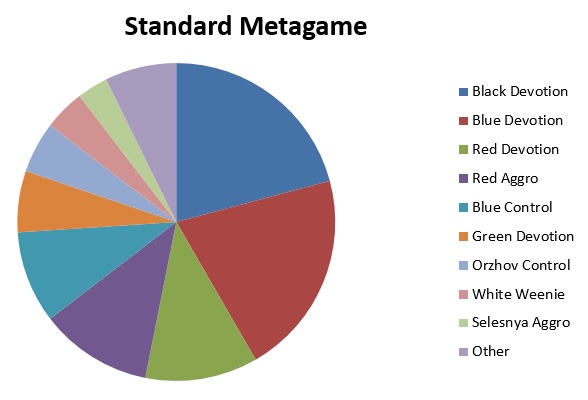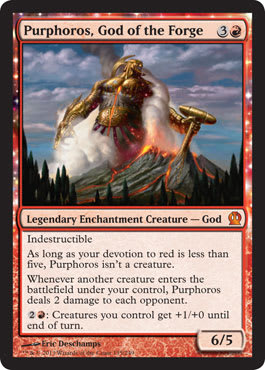Premier Events came back to Magic Online a couple of weeks ago, and it’s time to pore over some of the new data. I’ve compiled Top 16 decklists from five Premier Events dated December 16 to December 22 and added Grand Prix Shizuoka as well. Devotion decks are everywhere, as expected, although the popularity of certain other decks have waxed and waned. Let’s take a look:

Compared to what Standard looked like last time I ran the numbers, blue control decks have seen a large decrease in popularity, with red decks rising to take their place. The two top decks are mono-blue and mono-black devotion, both accounting for roughly 21% of the metagame. The rarity of green decks persists, although there is some small growth from last month. Taking responsibility for this is the barely-noticeable comeback of Selesnya aggro decks. It was among the most popular decks at the last Pro Tour, but once the devotion decks started to dominate, it disappeared almost entirely. Last, Orzhov control decks similar to the one that won Grand Prix Dallas have been seeing some minor success.
Unlike previous metagame articles, I’m going to start with the matchups table. I’ve already discussed the majority of decks represented above, so now I’d like to go into the nitty-gritty of certain matchups and go over the important sideboard cards. Here’s what the win percentages look like for the tournaments I surveyed:
| B Dev. | U Dev. | R Dev. | R Agg. | U Con. | G Dev. | W/B Con. | WW | G/W Agg. | Total | |
|---|---|---|---|---|---|---|---|---|---|---|
| B Dev. | 60% | 0% | 25% | 0% | 0% | 33% | ||||
| U Dev. | 40% | 33% | 33% | 67% | 100% | 0% | 44% | |||
| R Dev. | 100% | 67% | 0% | 0% | 43% | |||||
| R Agg. | 75% | 67% | 100% | 100% | 0% | 0% | 62% | |||
| U Con. | 100% | 33% | 0% | 0% | 29% | |||||
| G Dev. | 100% | 0% | 50% | |||||||
| W/B Con. | 100% | 0% | 100% | 67% | ||||||
| WW | 100% | 100% | 100% | |||||||
| G/W Agg. | 100% | 100% | 100% |
I would take the results of the last three decks—namely W/B control, white weenie, and Selesnya aggro—with a grain of salt since those had the smallest sample sizes by a wide margin. With the last two, the numbers were entirely from a single tournament won by that particular deck. In my mind, the big winner was red-based aggro, which had favorable win percentages against the majority of the field, only doing poorly against “fringe” decks such as W/B control and Selesnya aggro. Red aggro decks even did decently against mono-blue devotion, which challenged my assumptions about the matchup. You would think that with four copies each of Master of Waves and Tidebinder Mage that the outcome would heavily favor the blue deck, but that wasn’t the case in the data. Let’s take a look at a couple different flavors of red decks and see if we can figure out why it’s doing so well lately.
"Mono-Red Aggro by sandydogmtg"
- Creatures (31)
- 3 Chandra's Phoenix
- 4 Ash Zealot
- 4 Boros Reckoner
- 4 Burning-Tree Emissary
- 4 Fanatic of Mogis
- 4 Firedrinker Satyr
- 4 Firefist Striker
- 4 Rakdos Cackler
- Spells (8)
- 4 Lightning Strike
- 4 Shock
- Sideboard (15)
- 1 Chandra's Phoenix
- 2 Hammer of Purphoros
- 3 Mizzium Mortars
- 1 Mutavault
- 3 Peak Eruption
- 2 Seismic Stomp
- 3 Skullcrack
Also known as Brandon Burton (not the NFL player), sandydogmtg has been a Magic Online grinder for as long as I can remember. He definitely has a ton of experience playing mono-red, and he proved that it is still a contender in the current format by taking down a Premier Event with the above list. This deck’s game plan is to play cheap creatures early and often, use burn spells to clear blockers away, and finish the game with a Fanatic of Mogis. You’re aiming to win before your opponent’s more powerful late-game cards come online. Burton’s sideboard is designed to prevent his opponent from delaying the game. Hammer of Purphoros provides a steady stream of threats for when your opponent is able to sweep away your board. Mizzium Mortars takes care of pesky blockers that Lightning Strike can’t remove, such as Frostburn Weird and Gray Merchant of Asphodel. Peak Eruption might as well say, “Side this in against Chained to the Rocks.” I think Seismic Stomp is some pretty neat technology. It’s nice and cheap, and it provides an elegant way of winning through a stalled board.
Burton’s deck is an example of what I call a creature-based red deck—as opposed to a spell-based red deck like this one:
"Boros Aggro by Mezzel"
- Creatures (8)
- 4 Chandra's Phoenix
- 4 Young Pyromancer
- Spells (31)
- 3 Warleader's Helix
- 4 Boros Charm
- 4 Lightning Strike
- 4 Magma Jet
- 4 Shock
- 4 Skullcrack
- 4 Toil // Trouble
- 4 Chained to the Rocks
- Lands (21)
- 9 Mountain
- 4 Sacred Foundry
- 4 Temple of Silence
- 4 Temple of Triumph
- Sideboard (15)
- 4 Anger of the Gods
- 4 Peak Eruption
- 4 Spark Trooper
- 3 Wear // Tear
Make no mistake: This is a Young Pyromancer deck. I was actually surprised to see Storm Seeker in this deck, but I guess making it 1 mana cheaper was enough to make it good in a deck not based on Howling Mine. You can actually fuse it since the list does have four Temple of Silence, though I doubt it comes up all that often. 6 mana is a lot to ask for in a twenty-one-land deck, but having access to a Sign in Blood sometimes is nice. It keeps decks that draw a lot of cards, such as blue control and mono-black devotion, honest. They can’t draw too many cards for fear of being burned out. This deck makes the best use of Chandra's Phoenix that I’ve seen in this format. The huge number of burn spells ensures that it lives up to its namesake.
Because this list doesn’t have that many creatures, it can afford to run Anger of the Gods in the sideboard. It does a good job of clearing the board of most of mono-blue’s creatures and keeping that deck’s devotion nice and low. It doesn’t kill Master of Waves, but it does get rid of all the Elemental tokens. Anger of the Gods works wonders against creature-based red decks like Burton’s list I discussed above and any sort of white weenie deck—if you can catch white weenie without a Brave the Elements that is. Spark Trooper is an interesting choice, and I’m honestly not sure what matchup it would be good in.
One of the keys to winning with this deck is knowing when to throw your burn spells at your opponent’s face and when to hold back. It’s sometimes correct to Shock your opponent when he’s at 18 to make that Elemental token with Young Pyromancer. I’d definitely recommend playing a few games with this deck before taking it into a tournament to get a feel for when to cast your spells.
Last, I’ll touch base with what red devotion looks like. Though it plays similar cards to the two decks I discussed above, the deck plays out very differently. Here’s an example:
"R/w Devotion by im2g00t4ubarn"
- Creatures (26)
- 4 Ash Zealot
- 4 Boros Reckoner
- 4 Burning-Tree Emissary
- 4 Fanatic of Mogis
- 4 Frostburn Weird
- 4 Stormbreath Dragon
- 2 Purphoros, God of the Forge
- Planeswalkers (1)
- 1 Chandra, Pyromaster
- Spells (8)
- 3 Mizzium Mortars
- 3 Chained to the Rocks
- 2 Hammer of Purphoros
- Lands (25)
- 11 Mountain
- 2 Boros Guildgate
- 4 Sacred Foundry
- 4 Temple of Triumph
- 4 Nykthos, Shrine to Nyx
- Sideboard (15)
- 3 Anger of the Gods
- 3 Assemble the Legion
- 2 Boros Charm
- 1 Chained to the Rocks
- 1 Chandra, Pyromaster
- 1 Mizzium Mortars
- 1 Pithing Needle
- 2 Warleader's Helix
- 1 Wear // Tear
This list is all about abusing the heck out of Nykthos, Shrine to Nyx. All of the 2- and 3-mana creatures maximize the number of red mana symbols, so it’s not uncommon to play a Stormbreath Dragon a turn early. It’s even possible to play one on turn three, but that requires three copies of Burning-Tree Emissary. From that point, you can do some pretty disgusting things, such as overloading a Mizzium Mortars, activating a Stormbreath Dragon, pumping your team with Purphoros, God of the Forge, or just pooping out your whole hand. Fanatic of Mogis does a lot of work when nearly every card in your deck has a ton of red mana symbols and pressures your opponent’s life total.
Speaking of Purphoros, the red God is a pretty hilarious combo with Assemble the Legion. I’m not a huge fan of the token generator, as it’s only really good against mono-black, and even then, you have to fight through Thoughtseize and Duress. It’s not great against blue control decks since they have cards like Supreme Verdict and Detention Sphere, and it’s too slow against most other decks. It seems that mono-black is already a good matchup, so I don’t think Assemble the Legion is necessary. The rest of the sideboard is fairly straightforward, with a bunch of singletons of main-deck cards to shore up certain matchups. This deck performed very well against blue and black devotion but consistently lost to red aggro decks. Having more cheap removal in the sideboard can certainly help with aggressive matchups in general. Even something like Blind Obedience is worth considering. Try experimenting with different cards to see what works best for you.
There are definitely some options available to you if you want to sleeve up Mountains in Standard. If this increasing trend in red decks continues, it might be time to dust off your set of Voice of Resurgence. Whatever you choose to play, good luck in your upcoming Standard tournaments, and I’ll see you guys again next week.
Take care,
Nassim Ketita
arcticninja on Magic Online























